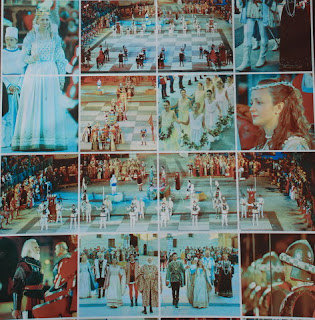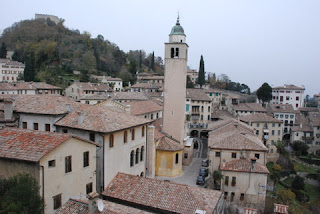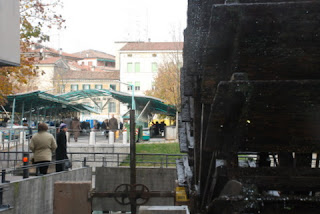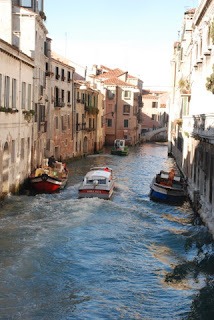


Took the bus into Aix en Provence for a quick walking tour of the town before we moved on. The campsite had provided a map and brief guide to the sights of the town and we picked out the ones that we wanted to see. Aix is a Roman town although, with the exception of the scant remains of the Roman baths on display at the modern Thermes Sextius, there is little to see. It does however have a very pleasant centre with some interesting architecture, cathedral (currently undergoing internal restoration work) and many small shops. It also has a tower in the main square housing am astronomical clock that has statues representing the four seasons that appear at the relevant time of the year - Autumn was on display holding a bunch of grapes. One of the main streets 'Cours Mirabeau' has a series of fountains, one of which reminded me of the fountain of Dulcote, near Wells, Somerset. Just like Dulcote, the 'Le Fontaine D'Eau Caude' is fed from a spring and a small spray of water issues out on to a grassy rock in the middle of the road. The difference is that the Aix fountain, as its name suggests, is fed from a hot spring and the water is indeed warm.
We returned to the campsite and, after lunch, left just after 13:00. Our destination was Avignon, just 90 minutes away and we enjoyed the non-motorway journey, stopping off at a hypermarket and wondering at the huge array of food available, and buying some!
We arrived in Avignon as the sun was beginning to set and this must be the best tine to see Avignon. I had obviously heard about the bridge, but I had no idea how attractive the town is. The walls are magnificent and the late, golden sun highlighted the walls and the bridge with a lovely yellow glow. I went to take photographs whilst Jane registered at the campsite and by the time that we had parked and walked back, the light had changed completely. Whilst I was taking the photographs, I met a French woman and we exchanged thoughts about the beauty of the view. She explained that she was a local inhabitant but had never seen that view in such a beautiful light.
Photos: Aix en Provence – clock tower in La Place de la Marie; Aix - La Fontaine d'Eau Chaude' (The Hot Water Fountain); Avignon walls and bridge in the late evening sun.
We returned to the campsite and, after lunch, left just after 13:00. Our destination was Avignon, just 90 minutes away and we enjoyed the non-motorway journey, stopping off at a hypermarket and wondering at the huge array of food available, and buying some!
We arrived in Avignon as the sun was beginning to set and this must be the best tine to see Avignon. I had obviously heard about the bridge, but I had no idea how attractive the town is. The walls are magnificent and the late, golden sun highlighted the walls and the bridge with a lovely yellow glow. I went to take photographs whilst Jane registered at the campsite and by the time that we had parked and walked back, the light had changed completely. Whilst I was taking the photographs, I met a French woman and we exchanged thoughts about the beauty of the view. She explained that she was a local inhabitant but had never seen that view in such a beautiful light.
Photos: Aix en Provence – clock tower in La Place de la Marie; Aix - La Fontaine d'Eau Chaude' (The Hot Water Fountain); Avignon walls and bridge in the late evening sun.
















































